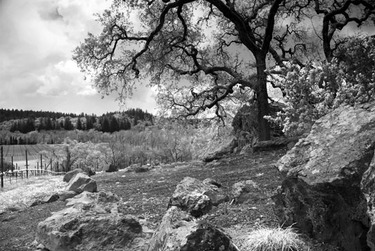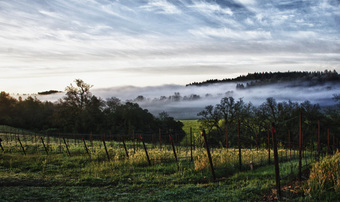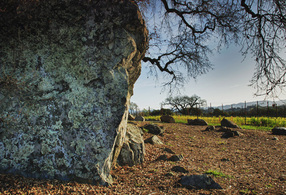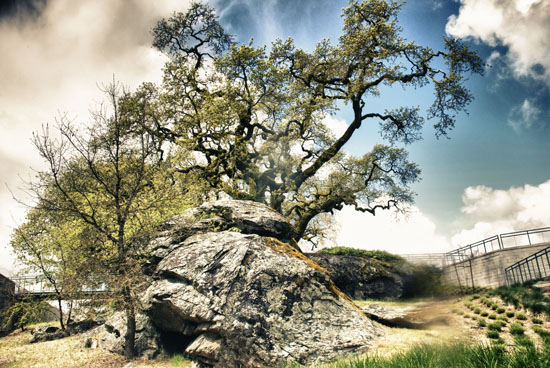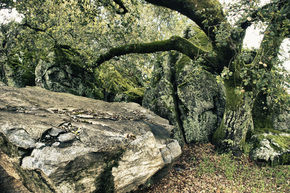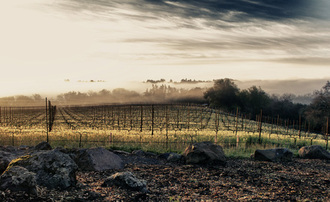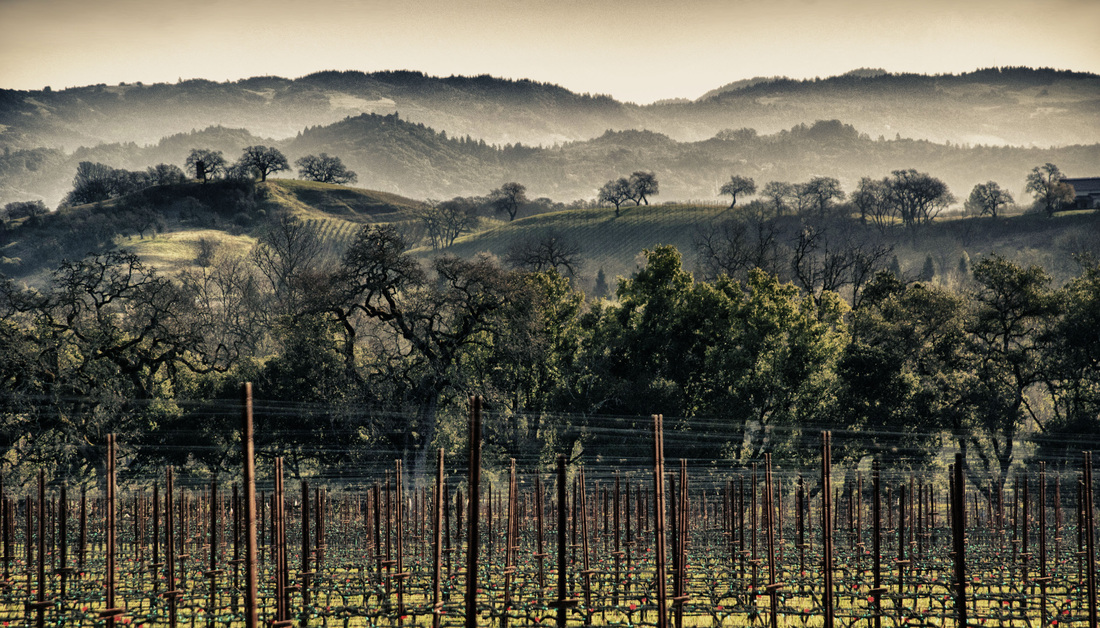Williams Selyem Estate Vineyard - Russian River
Story: Lisa Supple
Photography: Cathleen Francisco and Peter Griffith
Photography: Cathleen Francisco and Peter Griffith
Burt Williams and Ed Selyem released their first vintage in 1981 – a Pinot Noir made in their garage with Russian River fruit. When John and Kathe Dyson purchased the winery from the founders in 1998, they were determined to maintain the winery’s tight relationships with the growers whose fruit helped make Williams Selyem wines among the most highly coveted bottlings in California. WS still buys grapes from almost all those growers, but the Dysons also wanted a Russian River property they could call their own. They found it on Westside Road, about halfway between Guerneville and Healdsburg.
This stunning property is home to Williams Selyem’s sleek new winery and private visitors center. All secondary fermentations and barrel aging is done here. The crush pad and tanks for primary fermentations are located up the road at the Allen Vineyard, where Burt and Ed established their winemaking operations when they finally moved out of the garage.
This stunning property is home to Williams Selyem’s sleek new winery and private visitors center. All secondary fermentations and barrel aging is done here. The crush pad and tanks for primary fermentations are located up the road at the Allen Vineyard, where Burt and Ed established their winemaking operations when they finally moved out of the garage.
|
Entering through a discreet metal gate, the soft, rounded hills roll up from Westside Road, spotted with oaks and massive boulders – some the size of a Volkswagen bug, some the size of a VW bus. On one side of the glass-walled winery is a broad, exposed slope with sweeping views of the Russian River Valley; most of the fruit for the WS Estate Pinot Noir comes from this rocky hillside. On the other side is a deep swale from which the land rises again into a knob that had been planted to struggling prune and apple trees. Here the blocks have a great variety of soils and exposures, giving the winemakers a lovely spice rack of aromas and flavors for their blends.
|
When Vineyard Manager Chris Bowland started work on the vineyard in 2002, the first task was to clear the land. More than 10,000 tons of rock were extricated – a huge pile the size of the winery building. Some of those stones were used to create sheltering walls to protect the giant oaks. An integral part of the property, these 100+ year-old trees get lots of TLC and are monitored throughout the year by an arborist.
Planting of the grape vines began in 2003. Despite the mountain of boulders that was removed, the estate is still very rocky. In some places, the wide stakes that hold trellis wires at the end of a vine row just bent when they hit rock. So skinny stakes were used to pierce the earth.
Planting of the grape vines began in 2003. Despite the mountain of boulders that was removed, the estate is still very rocky. In some places, the wide stakes that hold trellis wires at the end of a vine row just bent when they hit rock. So skinny stakes were used to pierce the earth.
Walking the vineyard, you can see the soils change as you climb the slope. At the midpoint, it’s mostly red clay loam mixed with baseball to basketball sized rocks, becoming light tan and slightly less rocky as you move higher up.
The vineyard is planted with several rootstock/clone combinations. The rootstock for each block was selected first, then the clones were selected depending on the rootstock
and the block.
Clonal variety is a big topic when it comes to Pinot Noir. Clones are biologically identical cuttings that all originate from one plant, with minor mutations that have happened along the way. Pinot Noir is an older variety than, say, Cabernet Sauvignon, and tends to mutate more readily. There are hundreds of Pinot Noir clones around the world. Each varies slightly, but significantly, from the others, and each plays a subtle role in the crafting of a winery’s blends. “Winemaker Bob Cabral and owner John Dyson knew what clones they wanted and determined which ones were planted where,” said Chris Bowland. “Their favorite clones tended to land in their most favored spots.”
One three-acre block is randomly planted to all 15 clones, each vine with an identifying tag. The fruit from this Mass Selection block produces the Williams Selyem Block 10 Mass Selection Estate Pinot Noir, a wine only available in very small quantities to list members visiting the winery. In the future it may be used to produce field selections for future plantings. Unlike clones grown in a controlled nursery environment these vines “in the wild” will be subject and react to the whims of this particular site. Over the years, the winemakers will study the evolution of their growing patterns and distinct flavor profiles. Based on this research, budwood from the vines that display the most desirable characteristics will be used for future plantings – and one day may produce a unique WS Estate clone.
and the block.
Clonal variety is a big topic when it comes to Pinot Noir. Clones are biologically identical cuttings that all originate from one plant, with minor mutations that have happened along the way. Pinot Noir is an older variety than, say, Cabernet Sauvignon, and tends to mutate more readily. There are hundreds of Pinot Noir clones around the world. Each varies slightly, but significantly, from the others, and each plays a subtle role in the crafting of a winery’s blends. “Winemaker Bob Cabral and owner John Dyson knew what clones they wanted and determined which ones were planted where,” said Chris Bowland. “Their favorite clones tended to land in their most favored spots.”
One three-acre block is randomly planted to all 15 clones, each vine with an identifying tag. The fruit from this Mass Selection block produces the Williams Selyem Block 10 Mass Selection Estate Pinot Noir, a wine only available in very small quantities to list members visiting the winery. In the future it may be used to produce field selections for future plantings. Unlike clones grown in a controlled nursery environment these vines “in the wild” will be subject and react to the whims of this particular site. Over the years, the winemakers will study the evolution of their growing patterns and distinct flavor profiles. Based on this research, budwood from the vines that display the most desirable characteristics will be used for future plantings – and one day may produce a unique WS Estate clone.
|
The vines are densely planted to five foot by seven foot rows, trained on VSP (vertical shoot positioned) trellises. The average yield per acre is 2 to 3 tons.
Between the vine rows, the ground is sprinkled with tiny daisies, the wild chamomile seen throughout Russian River Valley. Chris also has put in several mixes of ground cover, which varies by zone. |
|
Acreage: 51 acres, 23 planted
Rootstock: Six rootstocks are used, selected to match soil types: 101-14, 3309, 420A, Riparia Gloire, 1103P and 161-49. Varietals: All Pinot Noir in the upper part of the estate Soils: Mostly Sobrante clay loam and Suther loam. |
Clones: 15 different clones of Pinot Noir. Williams Selyem’s “house clone” is Pommard, named for its home in Burgundy. Others planted at the WS Estate include Swan, propagated by Joseph Swan in the Russian River Valley; clones of Dijon, including 777 and 828; Mt. Eden (UCD 37); the Bruce clone from David Bruce’s vineyard in the Santa Cruz Mountains; Calera, from Josh Jensen’s Mt. Harlan vineyard in San Benito; Romani Conti from Burgundy and Clone A.
|
Topography: Most of the vineyard is a southeast-facing slope that rises about 100 feet from Westside Road. The grade is 15-20° at its steepest point at the top, where the vineyard is bordered by a forest of conifers, oaks and bay trees.
|
Owners: John and Kathe Dyson www.williamsselyem.com
Farmed by: Chris Bowland, Bowland Vineyard Management Access: Private; closed to the general public. Tours reserved for WS members. Grapes sourced by: Williams Selyem Winery, available to select restaurants and wine shops and in very limited amounts to the lucky 20,000+ people on the WS mailing list. |
